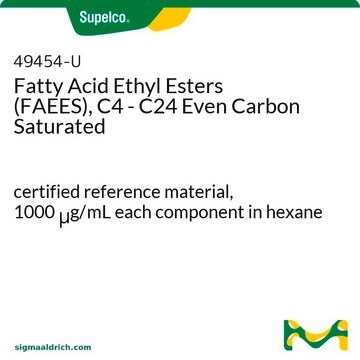W244104
Ethyl laurate
≥98%, FCC, FG
Synonym(s):
Ethyl dodecanoate, Ethyl laurate, Lauric acid ethyl ester
About This Item
Fragrance grade
Halal
Kosher
Recommended Products
biological source
synthetic
Quality Level
grade
FG
Fragrance grade
Halal
Kosher
Agency
follows IFRA guidelines
meets purity specifications of JECFA
reg. compliance
EU Regulation 1223/2009
EU Regulation 1334/2008 & 178/2002
FCC
FDA 21 CFR 117
FDA 21 CFR 172.515
Assay
≥98%
refractive index
n20/D 1.432 (lit.)
bp
269 °C (lit.)
density
0.86 g/mL at 25 °C (lit.)
application(s)
flavors and fragrances
Documentation
see Safety & Documentation for available documents
food allergen
no known allergens
fragrance allergen
no known allergens
Organoleptic
waxy; floral; soapy; sweet
SMILES string
CCCCCCCCCCCC(=O)OCC
InChI
1S/C14H28O2/c1-3-5-6-7-8-9-10-11-12-13-14(15)16-4-2/h3-13H2,1-2H3
InChI key
MMXKVMNBHPAILY-UHFFFAOYSA-N
Looking for similar products? Visit Product Comparison Guide
Related Categories
Application
- RIFM fragrance ingredient safety assessment, ethyl laurate, CAS Registry Number 106-33-2.: This study, published in Food and Chemical Toxicology, assesses the safety of ethyl laurate as a fragrance ingredient. The comprehensive review includes various toxicological endpoints and supports the safe use of ethyl laurate in fragrance formulations (Api et al., 2022).
- Application of a statistically enhanced, novel, organic solvent stable lipase from Bacillus safensis DVL-43.: This research explores the use of a novel lipase from Bacillus safensis in biocatalysis, highlighting its stability in organic solvents and its potential applications in the synthesis of ethyl laurate and other esters. The findings indicate significant improvements in enzymatic efficiency and potential industrial applications (Kumar et al., 2014).
Storage Class Code
10 - Combustible liquids
WGK
WGK 2
Flash Point(F)
235.4 °F - closed cup
Flash Point(C)
113 °C - closed cup
Personal Protective Equipment
Choose from one of the most recent versions:
Already Own This Product?
Find documentation for the products that you have recently purchased in the Document Library.
Customers Also Viewed
Global Trade Item Number
| SKU | GTIN |
|---|---|
| W244104-1DRUM-K | |
| W244104-4KG-K | 4061837544859 |
| W244104-9KG | |
| W244104-9KG-K | |
| W244104-SAMPLE | |
| W244104-1KG | |
| W244104-1KG-K | 4061837544835 |
| W244104-20KG | |
| W244104-20KG-K | 4061837512629 |
| W244104-4KG | |
| W244104-SAMPLE-K | 4061837512636 |
Our team of scientists has experience in all areas of research including Life Science, Material Science, Chemical Synthesis, Chromatography, Analytical and many others.
Contact Technical Service












